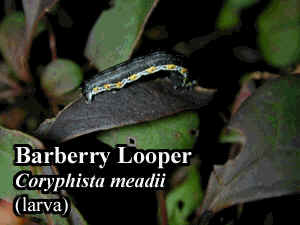Barberry (Berberis)
Plant Health Problems
Diseases caused by Fungi:
Wilt, Verticillium albo-atrum.
Yellowing of the leaves and wilting of shoots or entire plants is followed by
eventual death. Brownish discoloration of water-conducting tissues in wood is
characteristic. The causal fungus is soilborne and often infects a plant
through cultivator injuries. If barberry plants have died of wilt, replacements
should be planted elsewhere.
No control is known. It is advisable to avoid root injury in transplanting and
cultivation.
Rust, Puccinia graminis.
This fungus shows as bright orange pustules on the underside of the
barberry leaves in early summer. The alternate host is wheat and Merion
bluegrass. Many of the ornamental barberries are resistant to rust. Eradication
of barberries for protection of wheat and bluegrass was mandated in the past.
Control of rust on barberry is not usually warranted.
Insect Problems
Barberry aphid, Rhopalosiphum berberidis.
This small yellowish-green aphid is often very abundant on the leaves and
tender shoots, and sucks the sap. The dormant timing for horticultural oil
sprays will control overwintering insects while conserving natural enemies.
Among the compounds registered for control of this pest in Connecticut are
insecticidal soap, malathion and imidacloprid. A thorough spraying with
insecticidal soap or malathion when aphids are first noticed will give control.
Imidacloprid applied as a soil drench, gives season-long, systemic control.
Consult the label for dosage rates and safety precautions.
Barberry webworm, Omphalocera dentosa.
Blackish whitespotted caterpillars occasionally make webs on the twigs and
devour the leaves. The adult is a grayish brown moth with about a 2" wing
spread that belongs to the family Pyralidae (snout moths). Control is rarely
needed. In the event of an infestation, apply Bacillus thuringiensis var.
kurstaki, or spinosad, which are among the compounds registered for
control of this pest in Connecticut, to young caterpillars. Consult the label
for dosage rates and safety precautions.
Twobanded Japanese weevil, Callirhopalus bifasciatus.
The weevils, which consist of only females, feed on the margins of the leaves
of azalea, barberry, rhododendron and other shrubs, leaving characteristic
crescent-shaped notches. The weevil is about 1/5" long, robust, and varied
brown in color. The wing covers have faint whitish lines and whitish spots on
the apex. Spray acephate, which is registered for control of this pest in
Connecticut, in early August if many adults are noticed and damage is
intolerable. Consult the label for dosage rates and safety precautions.
 Barberry Looper, Coryphista meadii
Barberry Looper, Coryphista meadii
An
infrequent pest of barberry and Oregon Grapeholly, this inchworm overwinters as
a pupa buried in the soil. Brownish-gray moths with a 1.5" wingspan emerge
in May. After mating, females lay eggs singly on upper or lower leaf surfaces.
Larvae hatch in 3 – 4 days, are gray-black with lateral white stripes just
above the prolegs and begin to skeletonize leaves at night. At maturity, in 14
days, 1" long larvae can eat all leaf parts. Dropping to the soil, they
burrow in and pupate. There are multiple generations per year in Connecticut. In
the home landscape control measures are generally not needed. Among the
compounds registered for control of this pest in Connecticut are horticultural
oil, Bacillus thurengiensis and spinosad. In outbreak conditions
nurseries may use horticultural oil and Bacillus thurengiensis when
caterpillars are small.

